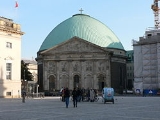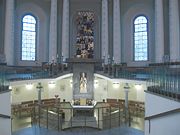
St. Hedwig's Cathedral
Encyclopedia
St. Hedwig's Cathedral is a Roman Catholic cathedral
on the Bebelplatz
in Berlin
, Germany
. It is the seat of the archbishop of Berlin
.
 It was built in the 18th century as the first Catholic church in Prussia
It was built in the 18th century as the first Catholic church in Prussia
after the Protestant Reformation
by permission of King Frederick II
. The intention of Frederick was to offer the numerous Catholic immigrants that had arrived in Berlin, especially those from Upper Silesia
, a place of worship. The church was therefore dedicated to the patron of Silesia
and Brandenburg
, Saint Hedwig of Andechs
. The building was designed by Georg Wenzeslaus von Knobelsdorff
modeled after the Pantheon in Rome
and construction started in 1747, interrupted and delayed several times due to economy measures. It was not until November 1, 1773 when the king's friend, Ignacy Krasicki
, then Bishop of Warmia (later Archbishop of Gniezno), officiated at the cathedral's opening in 1773.
After the Kristallnacht
pogroms that took place over the night of 9–10 November 1938, Bernhard Lichtenberg
, a canon
of the cathedral chapter
of St Hedwig since 1931, prayed publicly for Jews in the evening prayer following. Lichtenberg was later jailed by the Nazis and died on the way to the concentration camp at Dachau. In 1965 Lichtenberg's remains were transferred to the crypt
at St. Hedwig's.
The cathedral burned out completely in 1943 during air raids on Berlin and was reconstructed from 1952 up to 1963.
Cathedral
A cathedral is a Christian church that contains the seat of a bishop...
on the Bebelplatz
Bebelplatz
The Bebelplatz is a public square in the central Mitte district of Berlin, the capital of Germany.The square is located on the south side of the Unter den Linden boulevard, a major east-west thoroughfare in the city centre...
in Berlin
Berlin
Berlin is the capital city of Germany and is one of the 16 states of Germany. With a population of 3.45 million people, Berlin is Germany's largest city. It is the second most populous city proper and the seventh most populous urban area in the European Union...
, Germany
Germany
Germany , officially the Federal Republic of Germany , is a federal parliamentary republic in Europe. The country consists of 16 states while the capital and largest city is Berlin. Germany covers an area of 357,021 km2 and has a largely temperate seasonal climate...
. It is the seat of the archbishop of Berlin
Roman Catholic Archdiocese of Berlin
The Archdiocese of Berlin is a Roman Catholic archdiocese, seated in Berlin and covering the northeast of Germany.As of 2004 the archdiocese has 386,279 Catholics out of the population of Berlin, most of Brandenburg and Hither Pomerania, i. e. the German part of Pomerania...
.

Prussia
Prussia was a German kingdom and historic state originating out of the Duchy of Prussia and the Margraviate of Brandenburg. For centuries, the House of Hohenzollern ruled Prussia, successfully expanding its size by way of an unusually well-organized and effective army. Prussia shaped the history...
after the Protestant Reformation
Protestant Reformation
The Protestant Reformation was a 16th-century split within Western Christianity initiated by Martin Luther, John Calvin and other early Protestants. The efforts of the self-described "reformers", who objected to the doctrines, rituals and ecclesiastical structure of the Roman Catholic Church, led...
by permission of King Frederick II
Frederick II of Prussia
Frederick II was a King in Prussia and a King of Prussia from the Hohenzollern dynasty. In his role as a prince-elector of the Holy Roman Empire, he was also Elector of Brandenburg. He was in personal union the sovereign prince of the Principality of Neuchâtel...
. The intention of Frederick was to offer the numerous Catholic immigrants that had arrived in Berlin, especially those from Upper Silesia
Upper Silesia
Upper Silesia is the southeastern part of the historical and geographical region of Silesia. Since the 9th century, Upper Silesia has been part of Greater Moravia, the Duchy of Bohemia, the Piast Kingdom of Poland, again of the Lands of the Bohemian Crown and the Holy Roman Empire, as well as of...
, a place of worship. The church was therefore dedicated to the patron of Silesia
Silesia
Silesia is a historical region of Central Europe located mostly in Poland, with smaller parts also in the Czech Republic, and Germany.Silesia is rich in mineral and natural resources, and includes several important industrial areas. Silesia's largest city and historical capital is Wrocław...
and Brandenburg
Brandenburg
Brandenburg is one of the sixteen federal-states of Germany. It lies in the east of the country and is one of the new federal states that were re-created in 1990 upon the reunification of the former West Germany and East Germany. The capital is Potsdam...
, Saint Hedwig of Andechs
Hedwig of Andechs
Saint Hedwig of Silesia , also Saint Hedwig of Andechs from the comital House of Andechs was Duchess of Silesia from 1201 and of Greater Poland from 1231 as well as High Duchess consort of Poland from 1232 until 1238.-Life:...
. The building was designed by Georg Wenzeslaus von Knobelsdorff
Georg Wenzeslaus von Knobelsdorff
Hans Georg Wenzeslaus von Knobelsdorff was a painter and architect in Prussia.Knobelsdorff was born in Kuckädel, now in Krosno Odrzańskie County. A soldier in the service of Prussia, he resigned his commission in 1729 as captain so that he could pursue his interest in architecture...
modeled after the Pantheon in Rome
Pantheon, Rome
The Pantheon ,Rarely Pantheum. This appears in Pliny's Natural History in describing this edifice: Agrippae Pantheum decoravit Diogenes Atheniensis; in columnis templi eius Caryatides probantur inter pauca operum, sicut in fastigio posita signa, sed propter altitudinem loci minus celebrata.from ,...
and construction started in 1747, interrupted and delayed several times due to economy measures. It was not until November 1, 1773 when the king's friend, Ignacy Krasicki
Ignacy Krasicki
Ignacy Krasicki , from 1766 Prince-Bishop of Warmia and from 1795 Archbishop of Gniezno , was Poland's leading Enlightenment poet , a critic of the clergy, Poland's La Fontaine, author of the first Polish novel, playwright, journalist, encyclopedist, and translator from French and...
, then Bishop of Warmia (later Archbishop of Gniezno), officiated at the cathedral's opening in 1773.
After the Kristallnacht
Kristallnacht
Kristallnacht, also referred to as the Night of Broken Glass, and also Reichskristallnacht, Pogromnacht, and Novemberpogrome, was a pogrom or series of attacks against Jews throughout Nazi Germany and parts of Austria on 9–10 November 1938.Jewish homes were ransacked, as were shops, towns and...
pogroms that took place over the night of 9–10 November 1938, Bernhard Lichtenberg
Bernhard Lichtenberg
Blessed Bernhard Lichtenberg was a German Roman Catholic priest and theologian, awarded the title righteous among the Nations....
, a canon
Canon (priest)
A canon is a priest or minister who is a member of certain bodies of the Christian clergy subject to an ecclesiastical rule ....
of the cathedral chapter
Cathedral chapter
In accordance with canon law, a cathedral chapter is a college of clerics formed to advise a bishop and, in the case of a vacancy of the episcopal see in some countries, to govern the diocese in his stead. These councils are made up of canons and dignitaries; in the Roman Catholic church their...
of St Hedwig since 1931, prayed publicly for Jews in the evening prayer following. Lichtenberg was later jailed by the Nazis and died on the way to the concentration camp at Dachau. In 1965 Lichtenberg's remains were transferred to the crypt
Crypt
In architecture, a crypt is a stone chamber or vault beneath the floor of a burial vault possibly containing sarcophagi, coffins or relics....
at St. Hedwig's.
The cathedral burned out completely in 1943 during air raids on Berlin and was reconstructed from 1952 up to 1963.
Burials
- Konrad von PreysingKonrad von PreysingJohann Konrad Maria Augustin Felix Graf von Preysing Lichtenegg-Moos was a German prelate of the Roman Catholic Church...
- Alfred BengschAlfred BengschAlfred Bengsch was a German Cardinal of the Roman Catholic Church. He served as Bishop of Berlin from 1961 until his death, and was elevated to the cardinalate in 1967....
, in the crypt - Lorenz AdlonLorenz AdlonLorenz Adlon was a German caterer, gastronomer and hotelier.-Early life:Lorenz Adlon was born at Mainz. His original name had been Laurenz. He was the sixth out of nine children of the shoemaker Jacob Adlon and his wife Anna Maria Elisabeth, who was an accoucheuse...
, in the old cemetery of St. Hedwig's - Bernhard LichtenbergBernhard LichtenbergBlessed Bernhard Lichtenberg was a German Roman Catholic priest and theologian, awarded the title righteous among the Nations....
, in the crypt
External links
- www.hedwigs-kathedrale.de Parish of St. Hedwig, Berlin (with mass-schedule and english pages)

